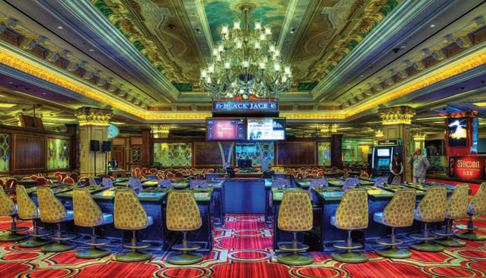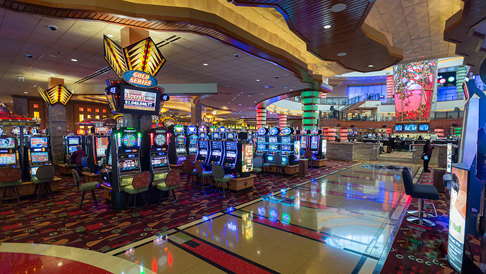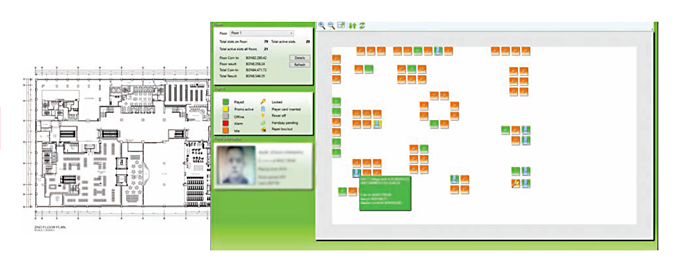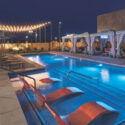 Interblock’s Stadium Blackjack at the Venetian
Interblock’s Stadium Blackjack at the Venetian Since time immemorial, businesses everywhere have spent innumerable hours trying to find ways to do more with less, especially in terms of maximizing return for a finite amount of square footage. For casino operators, the process of laying out an efficient and aesthetically pleasing gaming floor is one that has evolved alongside product design and advancements in technology, and there’s never one right answer. It’s sort of like playing golf or horseshoes—you’ll never achieve perfection; you just hope to do a little better over time, consistently.
Like most processes, the best floor layouts are the result of a combination of data and touch, a mingling of facts and feel. It’s a craft that takes years of experience and trial and error to properly understand. This is especially true in today’s industry, where tried-and-true concepts of supply and demand go hand-in-hand with New Age game designs and statistical models.
Casino amenities have certainly expanded and improved immensely over the years, but the gaming floor remains the heart of any property, the primary revenue driver. As such, the people tasked with arranging the floor have a crucial role to play in the success of a casino, even if their work is often nameless and behind the scenes. To some extent, this is true for suppliers as well, because if guests don’t like the way their games look or play, it doesn’t really matter where they’re located.
With that in mind, what does the ideal casino floor look like in 2022? It’s hard to say definitively, but two things are true above all: the strategies and outcomes are different than they were, say, in 1992, and they will undoubtedly change several more times come 2052.
A Gradual Evolution
In order to understand today’s practices, one must first revisit the ways of the past. After all, change usually doesn’t come quickly to the casino industry, and for many years it wasn’t necessary—markets weren’t nearly as saturated, and therefore there wasn’t much science to placing products. If operators had space, they filled it with machines and didn’t really think twice about it. Well-performing machines were the ones being played; what else could they be?

Pechanga Resort Casino has the largest casino floor on the West Coast, with 200,000 square feet of gaming space
Buddy Frank spent decades decoding the layout puzzle, overseeing slot operations for both commercial and tribal properties, including the Eldorado and Atlantis in Reno as well as California’s Viejas and Pechanga casinos. He now serves as a consultant through his BF Slot Strategies firm.
When he started in the industry, gaming floors “were just row after row after row, all straight rows” of machines, sometimes as many as “30, 40 machines along.” Even after tribal casinos started to pop up in the early-to-mid ’90s, this was still the case. However, once operators truly started to feel the pressure of competition, it became a race to keep players on-site, one that is still being fought today. The innovative operators, as Frank explains, started to incorporate sales principles from other industries.
“It was kind of a supply and demand thing,” says Frank. “The supply was very small, the demand was high. So the secret to success was the more slot machines, the better. And it worked well. As the markets matured everywhere—Nevada had matured first—people evolved in looking at basic principles of marketing that apply in anything else.
“I used to use models of grocery stores, where they’d put loss leaders in the back, so you’d have to walk through everything. The milk, eggs and bread are always in the back. That was one principle some people started to do. The other one, not everyone did this, but a few, modeled it after department stores—I would go into women’s fashion areas and they’d have all these little rounds and make you wander between these rounds to look at the dresses.”
Frank says that in a lot of cases, machine counts have been cut nearly in half from their peak numbers, which has presented both challenges and opportunities for operators to try new configurations that can produce similar or better returns. Fewer machines means more space, which leads to a more dynamic floor with more foot traffic. As operators started to experiment with this additional room, Frank notes, “they introduced a lot of confusion—and you ask, ‘why would you want to confuse your customer?’ Well, it’s also a sense of exploration.” It’s a delicate balance between curiosity and inconvenience, but the best performers can find ways to “confuse (guests) just enough to give them a sense of wonder.” The vast majority of today’s floors are a colorful embodiment of this concept, compared to the rigid, almost gloomy casinos of days past.
In addition to other properties, casinos have also found themselves in a position where they’re competing internally, in the sense that they now offer a full range of amenities that inevitably pull guests away from the gaming floor. Mark Birtha, president of Hard Rock Hotel and Casino Sacramento, has seen this evolution unfold over the past 30 years, both in Las Vegas and beyond.
“What you were seeing with the floor layouts was people started to
really think more as they started to see the revenue opportunity of all the non-gaming amenities, whether it was conventions or nightclubs or restaurants, entertainment—clearly most properties were still having those amenities sort of layered in around the floor, with the floor being the core of the building,” says Birtha. “You started to see people thinking more about the fact that whether it was hotel rooms or spas or restaurants, conventions, et cetera, there were clearly other ways to drive revenue in other customers to attract the marketplace.”
Birtha says that gradually, operators began to realize that floor layouts should work in tandem with outside amenities, and in order to do so, they had to move away from previous models, which favored “very dense floors” with “darker spaces and more compact areas.” Now that operators have evolved from the “mousetrap mentality” that was commonplace for many years, gaming floors “have opened up, in some cases become smaller, with circulation and visibility and openness and airiness,” allowing for a more comprehensive experience—after all, the name “integrated resort” is more literal than most may think.
Bright, Shiny and Big
Of course, floor designs are also somewhat dependent on the machines themselves, which have evolved to the point where they are almost unrecognizable from the games our grandparents played. The refrigerator-like, angular machines of old are now bulbous displays of visual technology, with high-definition monitors, touch features and cashless interfaces. Games are more complex and chock-full of bonuses and free spins and whatever else studios can come up with to differentiate themselves among floors where everyone stands out. Not only that, but new genres such as electronic table games (ETGs) and historical horse racing (HHR) have only expanded the number of possibilities for operators looking to diversify and streamline their layouts.
Of all game suppliers, perhaps none are more in tune with the design and layout processes than Interblock. As the market leaders for ETGs and related technology, the company makes some big games, the kind that require some brainstorming on behalf of property owners in order to fit them into the optimal space. Interblock Global CEO John Connelly says that over the years, his team has become elite at navigating layout and installation hiccups, which are crucial when it comes to scale of the company’s product setups, some of which are over 50 feet wide.
“We do our best to identify the optimal location in each casino, depending on the product, meaning not every product goes in the same location,” Connelly says. “Sometimes they go in different areas of casinos, but I believe we take more time identifying the optimal area on a casino floor to place our product than any other supplier in the world. And we do that with intent, meaning we have learned that an electronic table game player and where they prefer to spend their time versus a traditional table game player, a slot player, a bingo player, a keno player, poker player, is emphatically different. And for that reason, we spend more time upfront in the sales process than perhaps any other company we’re aware of.”

Interblock’s Stadium
The company’s Stadium setups are perhaps the most complex across the entire industry, which can be scaled up or down depending on how much room operators have to work with. According to Connelly, the success of the product line has allowed Interblock to “build an infrastructure that is dedicated to Stadium installations,” which is composed of “experts that know best practices, what to ask, how to help our customers prepare and organize themselves to do an installation.” In the past, this back-and-forth could take as long as four months, but that has been whittled down to under eight weeks for most cases.
Now that machines across the industry are becoming larger and flashier, all operators have had to adjust their practices, whether they be commercial, tribal or international. Birtha explains that as “technology has continued to advance,” the games “have become far more sophisticated and interactive and playful.” When he first came into the industry, nobody thought “there would ever be any focus on the box itself that the game sits on,” but now that today’s cabinets are defined by “curvature and comfort and ease of use,” it’s inspired property owners to place games further apart, to allow guests to enjoy this interactive experience more comfortably.
According to Frank, bigger, flashier machines may make for a better guest experience, but if operators aren’t careful, they can go too far and cause a sort of sensory overload, especially for those trying to navigate from one end of the floor to the other.
“Now these bigger machines are blocking sightlines and giving some attractions,” Frank says. “Remember I mentioned the milk and the eggs in the back of the store? Well, what if you put a giant, flashy Wheel of Fortune in an otherwise boring casino and put it in the back of the store? It attracts people like moss to a light. So those kinds of machines create visual distractions on the floor or visual attractions that attract people. The problem is now everyone does it. Now almost every machine is becoming like that, and it presents a whole new challenge to us on how to lay out our floor, because you have to be careful about sightlines that work.”
Mastering the Data

“Everything is driven by analytics, and that’s really where the industry has evolved to.” —Mark Birtha, President, Hard Rock Hotel and Casino Sacramento
Customer expectations and game design may have changed immensely over the years, but the technology and analytics on the back end have completely revolutionized the way operators go about arranging their floors. In today’s industry, it seems as though all roads lead back to data, and in many cases, the numbers win out in the end.
Machine and player performance are now the primary decision-makers when it comes to location and layout, and those who have rejected the technology have largely been left behind. The decisions that were once made by feel or instinct are now calculated—the positioning of each game has become chess on a grander, flashier scale, for the sake of peak efficiency and profit.
As Birtha says, “Everything is driven by analytics, and that’s really where the industry has evolved to.” Because of this, floors have become a lot more dynamic, as operators are “constantly moving games around, converting them, changing the banks, adding progressives, taking games off the floor, reusing space.” Due to the fact that companies now have the ability to track just about every transaction that takes place across the entire floor, well-performing machines are easier to identify, which “really allows us to reinvest into these customers cost-effectively, but also based on their preferences.”
Even suppliers like Interblock have jumped head-first into data collection, because it gives them a much better idea as to who is playing their games and why.
“We’ve begun doing much more analytics and data mining to try to understand who’s playing electronic table games around the world, and the various demographics,” says Connelly. “Fast-forward to today, we’ve learned infinitely more, and I use the word infinitely with intention, because the delta between where we were and where we are today is almost so great. It’s hard to explain. We continue to grow upon that on a daily and weekly basis.”
It’s become commonplace for operators to consult with heat maps and other data visualization models to see where and when traffic is highest for a particular machine or group of machines. However, slot directors have also learned that there’s a limit to what screens and numbers may tell you; at a certain point you also have to understand the human element of casinos, which takes time and experience. Sometimes it’s the little things that make a difference, details that data could never point out—what if, for example, the casino is in a cold climate, and nobody wants to sit at the machines closest to the door? Or perhaps you move your best machine right underneath a light fixture, and now no one can see the screen because of an awful glare.
As Frank points out, “In the old days it was totally shifted way too much to what you see and what you feel and not enough analytics. And today maybe a hair too much analytics.” The answer, then, lies somewhere in the middle, with equal parts art and science.
“You have to look at the analytics to understand machines like that because your gut feeling may say it isn’t productive. But when you look at the analytics it is. So those are critical to know. And I find an awful lot of colleagues who don’t use analytics make a lot of bad mistakes. Now, I’ll give you the other side of it—you can’t use analytics alone… You look at your analytics, it says a machine’s doing terrible, but you go down on the floor and look and you see that, my God, there’s a horrible glare coming off the screen from bad lighting. There’s a leak in the ceiling. The band always plays in it so loud they can’t hear.
“So it needs to be a nice healthy balance between good analytics and some old-fashioned shoe leather and talking to guests on the floor.”














